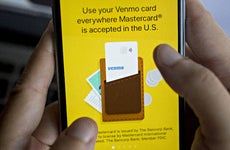Can you get COVID from a credit card?

The Bankrate promise
At Bankrate we strive to help you make smarter financial decisions. While we adhere to strict , this post may contain references to products from our partners. Here's an explanation for . The content on this page is accurate as of the posting date; however, some of the offers mentioned may have expired. Terms apply to the offers listed on this page. Any opinions, analyses, reviews or recommendations expressed in this article are those of the author’s alone, and have not been reviewed, approved or otherwise endorsed by any card issuer.
Over the past few years, the world’s top scientists have learned a great deal about the COVID-19 virus, including how it spreads from person to person. In the early years, a lack of legitimate research and data led both the public and public health officials to be suspicious of everything, since no one knew for sure how the virus could be transmitted. Ordinary activities, from pushing a supermarket shopping cart to shaking hands, turned into potential opportunities to catch and spread the virus.
Paper money and credit cards were also viewed as possible vectors, ushering a global shift to contactless payments. But were people really catching COVID from dollar bills and small pieces of plastic? A May 2022 Brigham Young University study shed light on the situation, revealing the odds and allaying unfounded concerns.
And though research from Imperial College London, published April 2023, found that the presence of SARS-CoV-2 on people’s hands and surfaces contributed to the spread of COVID-19, even the researchers determined that the data was weak.
Can you get COVID from cash?
Way back in 2020, the World Health Organization warned that cash could be a contributor to the spread of COVID. Consequently, it promoted paperless spending options such as contactless payments instead of using paper bills. Some people even began soaking dollar bills in Lysol to sterilize them. Chinese banks began disinfecting and isolating used banknotes with UV lights.
The BYU study, however, absolved paper currency of potential harm. The data it derived found that the SARS-CoV-2 virus is almost immediately nonviable when it is deposited on a cash banknote. It was nearly impossible to detect just 30 minutes after it was placed, with the virus being reduced by 99.9993 percent. No live virus at all was detected 24 and 48 hours afterward.
Therefore, the merchants who wanted to protect their employees and customers from the spread of COVID-19 by disallowing cash transactions can look back, knowing that the preventative measures they took may have been kind gestures, but had no measurable impact on abating transmission.
It’s also a good lesson for the future. Try to remain discerning and logical. According to Richard Robison, the BYU professor of microbiology and molecular biology who authored the study, the unfounded concern was driven by people who conducted no credible research before disseminating the information.
“These suppositions were made without any data behind them whatsoever,” says Robison. “It showed that the problems of blindly going down the road without anything to back it up. People and companies were making decisions based on no or bad data. So we decided to do the research ourselves.”
Can you get COVID from plastic?
The BYU study determined cash to be fine, but what about plastic payment tools? With the number of times people hold and use these items, many were worried that they were rife with dangerous germs.
In fact, early in the pandemic, news sources (including this one), recommended cleaning your credit cards to protect against the spread of the virus. By March 2021, CNBC was still advising cleaning and disinfecting credit cards as a way to offset COVID.
However, the BYU study found the live virus was reduced by 90 percent on money cards at the 30-minute mark. The reduction rate was 99.6 percent after four hours and 99.96 percent after 24 hours. The virus was still detectable on the money cards 48 hours later, but Robison rang no alarm bells.
“You just don’t get infected very often from fomites [inanimate objects that carry and spread disease and infectious agents] such as countertops, hard surfaces, and credit cards,” he says. “We found plenty of data to back up that that’s not how this virus is transmitted. It just doesn’t happen from this type of secondary transfer.”
For example, imagine a person has the COVID virus on their hands, Robinson says. They touch a credit card, contaminate it with the virus and then give the card to you. After holding the card, you touch your eyes, which are entry points for the virus. You still won’t be infected.
“There are diseases that are transmitted this way but COVID isn’t one of them,” says Robison.
While the Imperial College London study found that the virus was present on frequently touched surfaces in the household, and contacts were 3.8 times more likely to have detectable virus on their hands and 1.7 times more likely to be infected, the researchers hesitated to draw conclusions. The study was very limited in scope. Since it was based on observational data, causation could not be proven. Household air wasn’t systematically sampled, so airborne transmission couldn’t be ruled out.
COVID is in the air, not on financial instruments
According to Robison, you were and are most likely to contact COVID from what is floating in the air, not what’s living on your money or credit cards. “The particles and droplets hang around for hours after someone sneezes or coughs,” he says. “That’s how you can catch it.”
Amesh Adalja, senior scholar at Johns Hopkins Center for Health Security, whose work focuses on infectious diseases and pandemic policy, agrees. “There is no major risk of contracting COVID via credit cards or cash,” says Adalja. “It is an inefficient mode of transmission for the virus.”
While the longevity of airborne droplets and aerosols sounds alarming, Robison also stresses the natural lifecycle of COVID. Diseases become less virulent over time. The Centers for Disease Control and Prevention has monitored the situation from the beginning. As of April 14, 2023, the vast majority of the country is solidly in low transmission levels, and hospitalizations and deaths have flattened out.
If you have continued to maintain extraordinary protection strategies when using cash or credit cards (such as wearing gloves and sanitizing your bills or plastic), Robison assures that you can finally stop.
Traditional payment practices are safe, but pandemic era changes linger
In April 2023, the Biden Administration ended the national emergency for COVID-19. By then, many had already returned to their pre-pandemic habits. Some, though, remain cautious.
“It’s important when making risk calculations to actually understand where the risk is and isn’t,” says Adalja.
Still, not everyone has expanded their transaction options yet. For example, United Airlines still does not accept credit cards or cash, more than three years after that cautionary measure was adopted by the airline. All inflight purchases must be completed with contactless payments via the company’s app.
But times change, and so does scientific information.
“With what we know now about how COVID spreads, it should be business as usual when it comes to using financial products,” says Robison.
The bottom line
Whether or not the pandemic has permanently altered our payment practices remains to be seen. Habits developed over years can be hard to break. But with the overwhelming amount of scientific evidence, the public can be confident that cash and plastic cards were not COVID-19 vectors then, and they aren’t now. What many people did in an effort to stay healthy during an extremely confusing and frightening time can now be relegated to the history books.
Related Articles



